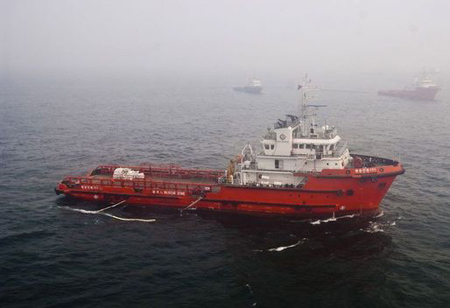(Ecns.cn) – ConocoPhillips China (COPC), a local branch of U.S.-based energy giant ConocoPhillips, is on the verge of being sued by China's maritime authority over an oil spill in China's Bohai Bay.
A legal team of eight companies will be set up by the end of August, culled from 49 Chinese law firms that have applied so far to offer legal assistance.
The suit comes as the deadline set by the government for a complete cleanup approaches, yet COPC admitted the discovery of nine new oil leaks from its Penglai 19-3 oilfield just last week.
On August 20, the China North Sea subsidiary of COPC said the new oil spill sources were found on the northwest side of Platform C of Penglai 19-3. On August 24, Georg Storaker, president of COPC China, said they had sealed up the platform that was involved and that his company would be able to finish cleaning up the spills before the deadline arrives.
However, on August 25, COPC told China News Service via email that cement injection to seal up the fault of the original oil spill source was only a plan and had not been carried out, and that the current device installed to collect the residual oil was not a permanent sealing measure.
The reason for the leakage remains hazy, although the oil spill has been basically controlled. But with massive numbers of scallops perishing off the coast of Hebei Province and the public increasingly in doubt, COPC has much left to answer for.
COPC claims oil did not pollute coast
According to an announcement on its official web site on August 19, "Currently there is no evidence that the oil sheen has arrived at or polluted the coastal beach," and "ConocoPhillips China did not find any case that the oil spill has affected marine life."
The announcement, designed as an apology, has caused increasing public skepticism over the company's handling of the disaster.
According to Xue Dongming, spokesperson and director of the Department of Corporate Communications and Corporate Social Responsibility at COPC, they had made themselves clear on the issue, but could not control public comment about their official explanation.
COPC said it had collected 56 specimens along the thousand-mile shoreline and sent them all to an independent laboratory. Among them, only two could be traced to the oil spill from Platform B of Penglai 19-3 oilfield, while another three were affected by Platform C.
The announcement was vague about inspection procedures and submission of specimens. COPC claimed that working staff inspected the shorelines meticulously every day and collected potential oil particles which were very small, in order to determine whether their composition was in accordance with oil spilled from platforms B or C.


















